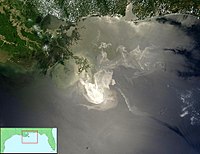
Photo from wikipedia
BACKGROUND During the 2010 Deepwater Horizon (DWH) disaster, oil spill response and cleanup (OSRC) workers were exposed to toxic volatile components of crude oil. Few studies have examined exposure to… Click to show full abstract
BACKGROUND During the 2010 Deepwater Horizon (DWH) disaster, oil spill response and cleanup (OSRC) workers were exposed to toxic volatile components of crude oil. Few studies have examined exposure to individual volatile hydrocarbon chemicals below occupational exposure limits in relation to neurologic function among OSRC workers. OBJECTIVES To investigate the association of several spill-related chemicals (benzene, toluene, ethylbenzene, xylene, n-hexane, i.e., BTEX-H) and total petroleum hydrocarbons (THC) with neurologic function among DWH spill workers enrolled in the Gulf Long-term Follow-up Study. METHODS Cumulative exposure to THC and BTEX-H across the oil spill cleanup period were estimated using a job-exposure matrix that linked air measurement data to detailed self-reported DWH OSRC work histories. We ascertained quantitative neurologic function data via a comprehensive test battery at a clinical examination that occurred 4-6 years after the DWH disaster. We used multivariable linear regression and modified Poisson regression to evaluate relationships of exposures (quartiles (Q)) with 4 neurologic function measures. We examined modification of the associations by age at enrollment (<50 vs. ≥50 years). RESULTS We did not find evidence of adverse neurologic effects from crude oil exposures among the overall study population. However, among workers ≥50 years of age, several individual chemical exposures were associated with poorer vibrotactile acuity of the great toe, with statistically significant effects observed in Q3 or Q4 of exposures (range of log mean difference in Q4 across exposures: 0.13-0.26 μm). We also observed suggestive adverse associations among those ≥ age 50 years for tests of postural stability and single-leg stance, although most effect estimates did not reach thresholds of statistical significance (p < 0.05). CONCLUSIONS Higher exposures to volatile components of crude oil were associated with modest deficits in neurologic function among OSRC workers who were age 50 years or older at study enrollment.
Journal Title: Environmental research
Year Published: 2023
Link to full text (if available)
Share on Social Media: Sign Up to like & get
recommendations!